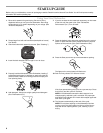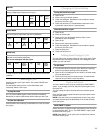
10
Rinse Aid Dispenser
Rinse aids prevent water from forming droplets that can dry as
spots or streaks. They also improve drying by allowing water to
drain off of the dishes during the final rinse. Your dishwasher is
designed to use a liquid rinse aid. Do not use a solid or bar-type
rinse aid.
Filling the dispenser
The rinse aid dispenser holds 3.4 oz (100 mL) of rinse aid. Under
normal conditions, this will last for about 1 to 3 months. You do
not have to wait until the dispenser is empty to refill it. Try to keep
it full, but be sure not to overfill it.
1. Make sure the dishwasher lid is fully open. Locate the rinse
aid fill on the right-hand side of the dishwasher back wall.
2. Open the rinse aid fill by unscrewing the cap.
3. Add rinse aid until container is full.
4. Clean up any spilled rinse aid with a damp cloth.
5. Replace the cap and tighten.
Rinse Aid Empty indicator
When the Rinse Aid Empty indicator is lit on the control panel,
you need to refill the rinse aid dispenser.
Dishwasher Performance Tips
Hot water dissolves and activates the dishwashing detergent.
Hot water also dissolves grease on dishes and helps glasses dry
spot-free. For best dishwashing results, water should be 120°F
(49°C) as it enters the dishwasher. Loads may not wash as well if
the water temperature is too low. Water that is too hot can make
some soils harder to remove and cause certain detergent
ingredients not to function.
■ If you have the hot water tank accessory installed, you can
significantly reduce the cycle times by using the high setting.
■ If you do not have a hot water tank accessory installed, you
can follow these steps to check your water temperature:
1. Run hot water at the faucet closest to your dishwasher for
at least 1 minute.
2. Place a candy or meat thermometer in a glass measuring
cup.
3. Check the temperature on the thermometer as the water
is running into the cup.
Additional efficiency tips
■ To save water and energy and time, do not rinse dishes
before putting them into the dishwasher.
■ Choose the cycle that describes the most difficult soil on
your dish load.
■ Do not worry about mixed loads. Any item that is
dishwasher safe can be washed using any cycle.
■ During the summer, run your dishwasher at night. This
reduces daytime heat buildup in the kitchen.
■ Use a rinse aid to improve drying.
■ Use cycles or options that add extra heat to the wash or
rinse portion of the cycle for better performance.
■ Run your dishwasher with full loads. Run a rinse cycle
after meals until the dishwasher is full.
■ If your home is equipped with a water softener, you may
want to avoid starting the dishwasher during the
regeneration of the softener, since this may contribute to
poor wash performance.
Cycle Selection Charts
Select the wash cycle and option desired or press the Start pad
to repeat the same cycle and option as the previous cycle.
NOTE: If the last cycle you completed was a rinse cycle, the
dishwasher will run the last full wash cycle and option that you
selected when you press the Start pad.
A “●” shows what steps are in each cycle.
Temperatures indicate where extra heat is added.
Water usage is shown in U.S. gallons/liters.
Cycle time includes dry time. An asterisk ( * ) by the cycle time
indicates the cycle time will be longer depending on the
temperature of the water entering the dishwasher. The cooler the
water, the longer the cycle time.
Rinse aid dispenser Rinse aid fill
Pots/Pans
Use this cycle for heavily soiled pots, pans, casseroles, and
regular tableware.
Main
Wash
Rinse Purge
†
Rinse Final
Heated
Rinse
Dry Time
(min)
Water
Usage
(gal/L)
●
145°F
(61°C)
●●●●
145°F
(61°C)
● 49* 4.1/
15.7


















